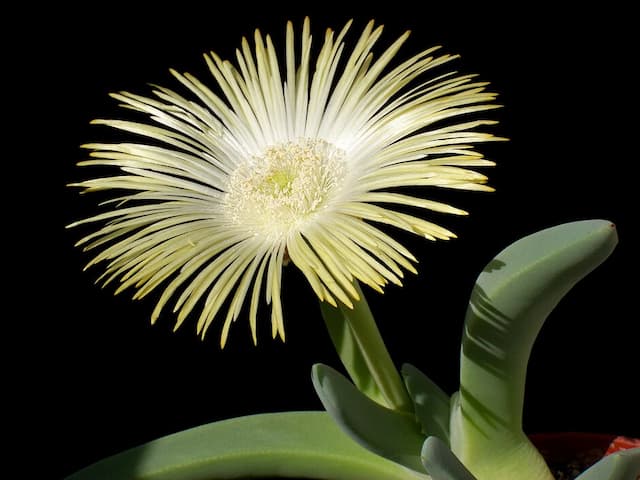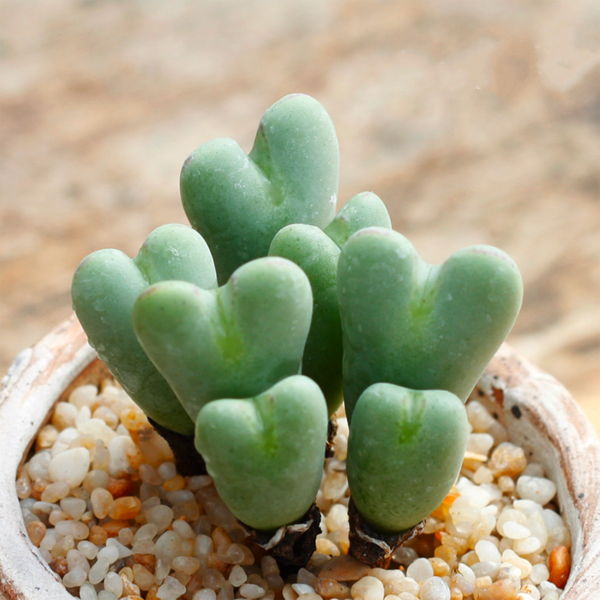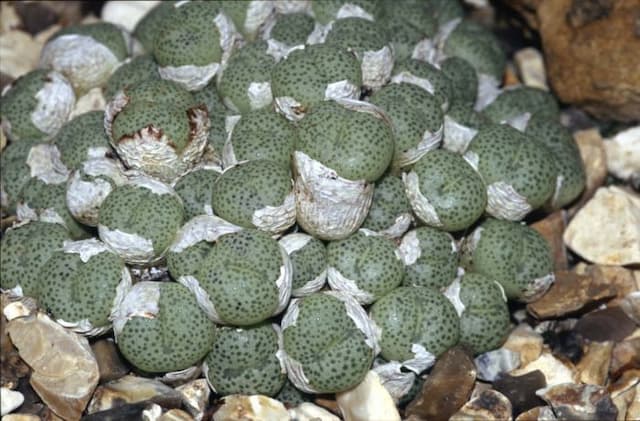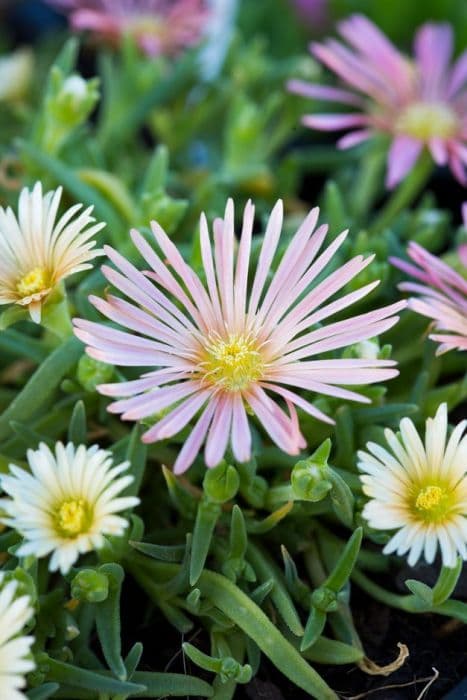Turtle Back Plant Cheiridopsis peculiaris

ABOUT
Cheiridopsis peculiaris, known commonly as Ice Plant, has a distinct appearance characterized by its fleshy, succulent leaves. These leaves are often arranged in pairs, tightly packed together to form compact structures that optimize water conservation. The leaves vary in color from a bright green to a blue-green hue and can have a glossy or slightly translucent quality, which gives the plant a unique, glistening appearance as though speckled with ice crystals, hence its common name. During blooming seasons, the Ice Plant produces vibrant flowers that stand out against the foliage. The blossoms can range in color from bright yellow to orange and are daisy-like in shape, featuring numerous slender petals radiating from a central core. These contrasting colors create a striking visual display that adds to the plant's peculiar charm. The plant's overall structure, being a succulent, is well-adapted to arid environments. The thick leaves store water, allowing the plant to survive long periods without rainfall. The compact growth habit of the Ice Plant minimizes the surface area exposed to the harsh sun and drying winds, further aiding in water retention. In summary, the Ice Plant's intriguing appearance, with its plump leaves, shiny surface, and eye-catching flowers, make it a unique and attractive plant well-suited to dry landscapes or rock gardens where it can truly stand out and showcase its peculiar beauty.
About this plant
 Names
NamesFamily
Aizoaceae.
Synonyms
No common names available.
Common names
Cheiridopsis peculiaris
 Toxicity
ToxicityTo humans
Cheiridopsis peculiaris, more commonly known as the Ice Plant, is not widely recognized for its toxicity to humans. There is limited information on the plant causing adverse effects if ingested. However, as with any plant, individual allergies or sensitivities could potentially cause mild irritation or allergic reactions. Consuming any non-food plant should be done with caution, and it is generally advised to avoid eating plants that are not confirmed as safe for human consumption.
To pets
Cheiridopsis peculiaris, commonly referred to as the Ice Plant, does not have a well-documented history of toxicity to pets such as cats and dogs. While it is not specifically listed as toxic, it is generally recommended to prevent pets from ingesting plants that are not known to be safe. If a pet were to ingest a part of this plant, it is advisable to monitor them for any signs of discomfort, such as vomiting or diarrhea, and consult a veterinarian if any symptoms arise. However, the likelihood of serious poisoning from this plant appears to be low based on available information.
 Characteristics
CharacteristicsLife cycle
Perennials
Foliage type
Evergreen
Color of leaves
Green
Flower color
Yellow
Height
0.16 feet (5 cm)
Spread
0.5 feet (15 cm)
Plant type
Succulent
Hardiness zones
10
Native area
South Africa
Benefits
 General Benefits
General Benefits- Drought Resistance: As a succulent, Cheiridopsis peculiaris is highly adapted to arid conditions, making it a great choice for water-wise gardens or regions with limited rainfall.
- Easy Maintenance: This plant typically requires little care beyond the basics, making it ideal for those new to gardening or those with limited time.
- Attractive Foliage: With its interesting leaf textures and forms, Cheiridopsis peculiaris adds visual interest to any plant collection or garden setting.
- Ground Cover: Its spreading habit can provide a natural carpet of greenery, helping to stabilize soil and reduce erosion.
- Container Gardening: Cheiridopsis peculiaris is well-suited for pots and planters, making it a versatile choice for patio gardens, balconies, and indoor settings.
- Ecological Benefits: Like many plants, it contributes to biodiversity, offering habitat and sometimes food sources for a variety of insects and other small wildlife.
- Seasonal Interest: Many Cheiridopsis species, including Cheiridopsis peculiaris, produce flowers that can add seasonal color and beauty to gardens.
 Medical Properties
Medical PropertiesThis plant is not used for medical purposes.
 Air-purifying Qualities
Air-purifying QualitiesThis plant is not specifically known for air purifying qualities.
 Other Uses
Other Uses- Cheiridopsis peculiaris, also known as 'peculiar fingers', can be used in miniature succulent gardens due to its compact size and interesting shape, adding diversity to the plant composition.
- This plant is ideal for creating textured patterns in drought-resistant landscaping, as it provides a unique, finger-like appearance which contrasts well with other succulent forms.
- Peculiar fingers can serve as an educational tool in botany classes to demonstrate the diversity of succulent adaptations in arid environments.
- The plant can be cultivated for use in artistic installations or as living sculptures, especially in environments that emulate their native arid conditions.
- Peculiar fingers can be potted in transparent containers to showcase their interesting root structures as well as their above-ground features.
- This species can be used in photography, particularly macro photography, due to its intricate patterns and textures that are highlighted when viewed up close.
- They can be utilized in thematic garden designs that replicate lunar or extraterrestrial landscapes, due to their unusual and otherworldly appearance.
- Peculiar fingers may be used as a natural way to teach children and adults about water conservation, as its ability to thrive in dry conditions exemplifies efficient water use.
- This plant can be used as a natural barrier within rock gardens or xeriscape landscapes, due to its firm structure and low-growing habit.
- Cheiridopsis peculiaris may act as inspiration for designers and architects who are looking for organic shapes and sustainable models in their work.
Interesting Facts
 Feng Shui
Feng ShuiThe Cheiridopsis peculiaris is not used in Feng Shui practice.
 Zodiac Sign Compitability
Zodiac Sign CompitabilityThe Cheiridopsis peculiaris is not used in astrology practice.
 Plant Symbolism
Plant Symbolism- Resilience: Cheiridopsis peculiaris is known for its ability to thrive in harsh, arid environments, symbolizing the capacity to endure and prosper in the face of adversity.
- Adaptability: This plant can adapt to extreme conditions, representing the importance of flexibility and being able to adjust to changing circumstances.
- Rarity: As suggested by its name, peculiaris, this plant is uncommon, symbolizing the uniqueness and value of rare traits or entities.
- Beauty in Simplicity: With its understated appearance, Cheiridopsis peculiaris reminds us that there is beauty and elegance in simplicity and minimalism.
- Survival: The plant's capability to store water in its leaves for use during drought periods represents the theme of survival and the idea of preparation for future challenges.
 Water
WaterThe Cheiridopsis peculiaris, commonly known as the Dainty Doll houseplant, should be watered approximately every two weeks, with variations depending on the season and the plant's dormancy period. During the summer, you might need to water slightly more frequently, while in winter, less often. Provide the equivalent of about 4 ounces of water at each watering, ensuring the soil is dry between waterings to prevent root rot. Avoid letting the plant sit in water, and always water at the base, not from overhead, to keep the foliage dry.
 Light
LightDainty Doll houseplants require bright, indirect sunlight to thrive. They are best placed in a spot that receives ample morning sunlight but is shaded from the harsher afternoon sun. Avoid deep shade or extended periods of direct midday sun, as both can be detrimental to the plant's health.
 Temperature
TemperatureDainty Doll houseplants prefer a temperature range between 50°F and 75°F. They can survive temperature dips down to about 40°F but should not be exposed to freezing temperatures. The ideal temperature for fostering growth in Dainty Doll houseplants is around 65° to 70°F.
 Pruning
PruningPruning of Dainty Doll houseplants is generally not necessary as they are slow-growing succulents. However, if necessary, remove any dead or damaged leaves to maintain the plant's appearance. Pruning is best done in the springtime when the plant is coming out of dormancy and before it begins its active growing phase.
 Cleaning
CleaningAs needed
 Soil
SoilThe mimicry plant, or Cheiridopsis peculiaris, thrives in a well-draining cactus mix with sharp sand or perlite added to increase drainage. The soil pH should be neutral to slightly acidic, ideally between 6.0 and 7.5. For optimal growth, make sure the soil is porous and allows for quick drying after watering.
 Repotting
RepottingThe mimicry plant generally needs to be repotted every two to three years or when it outgrows its pot. It is best to repot this succulent at the end of its dormancy period just before the growing season begins.
 Humidity & Misting
Humidity & MistingFor the mimicry plant, maintaining low to moderate humidity levels is ideal, avoiding overly damp conditions which can encourage rot. Dry air typically found in a home environment is usually sufficient.
 Suitable locations
Suitable locationsIndoor
Place the mimicry plant in bright light, minimal water.
Outdoor
Full sun to partial shade, well-draining soil.
Hardiness zone
9-11 USDA
 Life cycle
Life cycleCheiridopsis peculiaris, commonly known as the egg-and-bacon plant, begins its life cycle as a seed that germinates, usually in response to adequate moisture conditions. Seedlings develop fleshy leaves adapted for water storage, a characteristic of many succulents. The juvenile plant matures over several years, adapting to its arid environment by developing a deep root system and a rosette of leaves. During its adult phase, Cheiridopsis peculiaris produces vibrant yellow flowers, typically in the winter to early spring months, to attract pollinators. After successful pollination, fruits develop, containing seeds that, when dispersed, complete the reproductive cycle of the plant. Throughout its life, the plant undergoes periods of dormancy during hot and dry seasons, allowing it to survive until favorable conditions return.
 Propogation
PropogationPropogation time
Spring to Summer
Cheiridopsis peculiaris, also known as the mimicry plant due to its ability to blend with its surroundings, is commonly propagated through seed sowing. The ideal time to sow seeds is in the autumn when the temperature is cooler. The process involves scattering the seeds on a well-draining soil mix and lightly covering them with a thin layer of sand or the same substrate material. This should be followed by watering with a gentle mist to avoid disrupting the seeds. The sown seeds need to be kept in a warm, bright area but out of direct sunlight, and the substrate should be kept moist but not waterlogged to encourage germination. It typically takes one to three weeks for the seeds to germinate. After the seedlings develop and are large enough to handle, they can be transplanted carefully into their individual pots or a permanent location.









